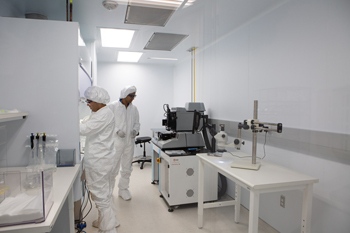Honey, I shrunk the lab: Technology for making small devices has a big impact for St. Michael’s and Ryerson researchers

By Ana Gajic

Using tools at the Microfabrication Core, researchers can shrink their experiments to happen on a surface that’s about the size of a credit card. The Clean Room allows for the area to remain clear of dust particles as the small experiment is being built.
In medical imaging research, bubbles that are too small to be seen by the naked eye can help scientists see things they’ve never seen before – and St. Michael’s Hospital now has the tools on-site to create, control and validate them through research.
Dr. Scott Tsai, the theme lead for Biomedical Delivery Systems at the Institute for Biomedical Engineering, Science and Technology (iBEST) of St. Michael’s and Ryerson University, creates tiny bubbles that can be injected into a patient’s blood stream for medical imaging of cancer and heart disease. Because bubbles have a gas core, they compress more than the surrounding tissue and blood when they’re exposed to ultrasound, providing a far clearer ultrasound image. These bubbles are smaller in diameter than a hair follicle.
“Until now, we’ve had to outsource the tools to create these bubbles because we didn’t have the resources on-site to create them,” Dr. Tsai said. “But with the opening of the Microfabrication Core at St. Michael’s, cell biology and molecular biology researchers at iBEST and the Keenan Centre for Biomedical Science (KRCBS) now have easy access to these specialized tools.”
Working with such tiny systems requires a special set of resources, now contained in the newly-completed Microfabrication Core. These tools allow researchers like Dr. Tsai to work with microfluidics, which is the science of manipulating and controlling fluids to create tiny materials such as the injectable bubbles and the miniscule systems needed to make them.
“Our mandate is to support researchers at the KRCBS and iBEST through this set of devices, which include a 3D printer and analytical equipment,” said Dario Bogojevic, a specialist in Research Core Facilities at St. Michael’s. His team will provide group and individual trainings for researchers and their students, along with protocol development, device design and data analysis.
Using these tools, researchers can shrink their experiments to happen on a surface that’s about the size of a credit card. In biology, these are called ‘lab-on-a-chip’ devices. The Microfabrication Core will not only allow scientists to develop tiny and powerful experiments in-house, it will also allow researchers to adapt their experiments quickly.
“Because everything is much smaller, reactions happen very fast,” Dr. Tsai said. “If you do an experiment, and it doesn’t work, you can build another one. This will allow my team to rapidly refine our designs for lab-on-a-chip devices that fabricate bubbles for ultrasound imaging research.”
Beyond bubbles, other uses for the Microfabrication Core include the ability to make single-cell droplets that show scientists the actions and responses of one cell at a time, which cannot be done in a petri dish where multiple cells are tested at once. This facility also creates the opportunity to develop organ-on-a-chip devices that reenact the function of an organ in a small space before testing on live models.
“The Microfabrication Core represents the intersection of science, health and engineering – just as iBEST was designed to do,” said Dr. Ori Rotstein, director of the KRCBS and co-chair of iBEST. iBEST is a unique partnership that brings together Ryerson’s engineering and science strengths with St. Michael’s research and clinical expertise in a 22,000-square-foot, state-of-the-art laboratory where scientists and engineers test practical ideas that can be brought to the patient bedside quickly.
The Microfabrication Clean Room was developed as part of the iBEST construction agreement in the Keenan Research Centre building. A recent Canada Foundation for Innovation grant with the University of Toronto for Dr. Tsai, along with the Natural Sciences and Engineering Research Council of Canada and Ryerson University, funded the equipment now contained in the Microfabrication Core.
“With these tools, people can imagine new experiments they couldn’t before,” Dr. Tsai said.
“They can build them in-house and they can be really fast. This new facility brings iBEST to a whole new frontier of research.”
About St. Michael’s Hospital
St. Michael’s Hospital provides compassionate care to all who enter its doors. The hospital also provides outstanding medical education to future health care professionals in more than 29 academic disciplines. Critical care and trauma, heart disease, neurosurgery, diabetes, cancer care, care of the homeless and global health are among the Hospital’s recognized areas of expertise. Through the Keenan Research Centre and the Li Ka Shing International Healthcare Education Centre, which make up the Li Ka Shing Knowledge Institute, research and education at St. Michael’s Hospital are recognized and make an impact around the world. Founded in 1892, the hospital is fully affiliated with the University of Toronto.
St. Michael’s Hospital with Providence Healthcare and St. Joseph’s Health Centre now operate under one corporate entity as of August 1, 2017. United, the three organizations serve patients, residents and clients across the full spectrum of care, spanning primary care, secondary community care, tertiary and quaternary care services to post-acute through rehabilitation, palliative care and long-term care, while investing in world-class research and education.
